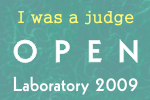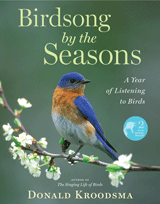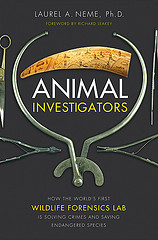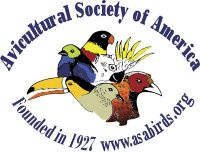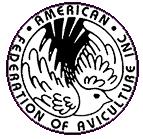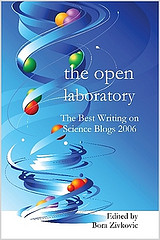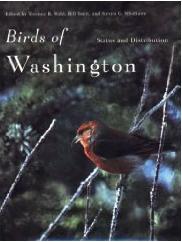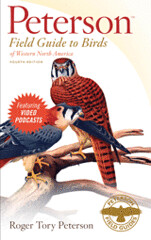tags: Birdbooker Report, bird books, animal books, natural history books, ecology books
"How does one distinguish a truly civilized nation from an aggregation of
barbarians? That is easy. A civilized country produces much good bird
literature."
--Edgar Kincaid

The Birdbooker Report is a special weekly report of a wide variety of science, nature and behavior books that currently are, or soon will be available for purchase. This report is written by one of my Seattle birding pals and book collector, Ian "Birdbooker" Paulsen, and is edited by me and published here for your information and enjoyment. Below the fold is this week's issue of The Birdbooker Report which lists ecology, environment, natural history and bird books that are (or will soon be) available for purchase.
FEATURED TITLES:
- Peterson, Roger Tory. Peterson Field Guide to Birds of Eastern and Central/Western North America (sixth and fourth editions). 2010. Houghton Mifflin Harcourt. Flexibinding: 445 pp. and 493 pp. respectively. Price: $19.95 U.S. each. [Amazon: $13.57 (Western) and Amazon: $13.57 (Central)].
SUMMARY: The familiar Peterson eastern/western bird guides have been updated using the plates from the 2008 Peterson Field Guide to Birds of North America. The text and range maps have been updated and in a smaller format designed for use in the field. More than three hours of video podcasts supplement these guides.
RECOMMENDATION: Still the best guides for beginning birders in North America!
New and Recent Titles:
-
 Milan, Erika Lorraine. Looking for a Few Good Males: Female Choice in Evolutionary Biology. 2010. Johns Hopkins University Press. Hardbound: 236 pages. Price: $60.00 U.S. [Amazon: $46.89].
Milan, Erika Lorraine. Looking for a Few Good Males: Female Choice in Evolutionary Biology. 2010. Johns Hopkins University Press. Hardbound: 236 pages. Price: $60.00 U.S. [Amazon: $46.89].
SUMMARY: Why do female animals select certain mates, and how do scientists determine the answer? In considering these questions, Erika Lorraine Milam explores the fascinating patterns of experiment and interpretation that emerged as twentieth--century researchers studied sexual selection and female choice. Approaching the topic from both biological and animal -- studies perspectives, Milam not only presents a broad history of sexual selection -- from Darwin to sociobiology -- but also analyzes the animal -- human continuum from the perspectives of sex, evolution, and behavior. She asks how social and cultural assumptions influence human -- animal research and wonders about the implications of gender on scientific outcomes.
RECOMMENDATION: For those with an interest in the role that sexual selection plays in evolutionary biology. -
 Pechenik, Jan A. Biology of the Invertebrates (Sixth edition). 2010. McGraw-Hill. Hardbound: 606 pages. Price: $149.00 U.S. [Amazon: $115.21].
Pechenik, Jan A. Biology of the Invertebrates (Sixth edition). 2010. McGraw-Hill. Hardbound: 606 pages. Price: $149.00 U.S. [Amazon: $115.21].
SUMMARY: This textbook is the most concise and readable invertebrates book in terms of detail and pedagogy (other texts do not offer boxed readings, a second color, end of chapter questions, or pronunciation guides). All phyla of invertebrates are covered (comprehensive) with an emphasis on unifying characteristics of each group.
RECOMMENDATION: a college level textbook. -
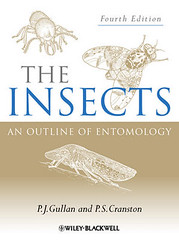 Gullan, P.J. and P. S. Cranston. The Insects: An Outline of Entomology (4th edition). 2010. Wiley-Blackwell. Hardbound: 565 pages. Price: $100.00 U.S. [Amazon: $80.00].
Gullan, P.J. and P. S. Cranston. The Insects: An Outline of Entomology (4th edition). 2010. Wiley-Blackwell. Hardbound: 565 pages. Price: $100.00 U.S. [Amazon: $80.00].
SUMMARY: This established, popular textbook provides a stimulating and comprehensive introduction to the insects, the animals that represent over half of the planet's biological diversity. In this new fourth edition, the authors introduce the key features of insect structure, function, behavior, ecology and classification, placed within the latest ideas on insect evolution. Much of the book is organized around major biological themes -- living on the ground, in water, on plants, in colonies, and as predators, parasites/parasitoids and prey. A strong evolutionary theme is maintained throughout. The ever-growing economic importance of insects is emphasized in new boxes on insect pests, and in chapters on medical and veterinary entomology, and pest management. Updated "taxoboxes" provide concise information on all aspects of each of the 27 major groupings (orders) of insects.
RECOMMENDATION: another college level textbook. -
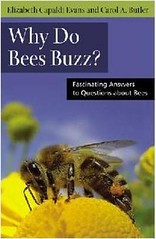 Evans, Elizabeth Capaldi and Carol A. Butler. Why Do Bees Buzz? Fascinating Answers to Questions about Bees. 2010. Rutgers University Press. Paperback: 229 pages. Price: $21.95 U.S. [Amazon: $16.46].
Evans, Elizabeth Capaldi and Carol A. Butler. Why Do Bees Buzz? Fascinating Answers to Questions about Bees. 2010. Rutgers University Press. Paperback: 229 pages. Price: $21.95 U.S. [Amazon: $16.46].
SUMMARY: With clarity and depth, bee biologist Elizabeth Capaldi Evans and coauthor Carol A. Butler examine the lives of honey bees, as well as other species such as orchid bees, bumblebees, and stingless bees. Accessible to readers on every level, and including the latest research and theory for the more sophisticated reader, the authors reveal more than one hundred critical answers to questions about the lives of bees. Concepts about speciation, evolutionary adaptation and pollination, as well as historical details about topics such as Mayan beekeeping and the appearance of bees in rock art, are arranged in easy-to-follow sidebars that highlight the text. Color and black and white photographs and drawings enhance the beauty and usefulness of Why Do Bees Buzz?
RECOMMENDATION: A good general introduction to the biology and conservation of bees. -
 Tolman, Tom and Richard Lewington. Collins Butterfly Guide. 2009.
Tolman, Tom and Richard Lewington. Collins Butterfly Guide. 2009.
Collins. Paperback: 384 pages. Price: $34.95 U.S. [Amazon: $26.56].
SUMMARY: This field guide to the butterflies of Britain and Europe features over 400 species, depicting both male and female insects. Species descriptions include details on taxonomic nomenclature, distribution, flight period, variation, habitat, behavior and life cycle. Subspecies are included where there is significant variation, and distribution maps accompany each widespread species.
RECOMMENDATION: A well illustrated guide to the butterflies of Europe. -
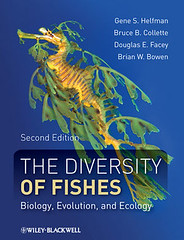 Helfman, Gene S. et al. The Diversity of Fishes: Biology, Evolution, and Ecology (2nd edition). 2010. Wiley-Blackwell. Hardbound: 720 pages. Price: $129.95 U.S. [Amazon: $102.71].
Helfman, Gene S. et al. The Diversity of Fishes: Biology, Evolution, and Ecology (2nd edition). 2010. Wiley-Blackwell. Hardbound: 720 pages. Price: $129.95 U.S. [Amazon: $102.71].
SUMMARY: The second edition of The Diversity of Fishes represents a major revision of the world's most widely adopted ichthyology textbook. Expanded and updated, the second edition is illustrated throughout with striking color photographs depicting the spectacular evolutionary adaptations of the most ecologically and taxonomically diverse vertebrate group. The text incorporates the latest advances in the biology of fishes, covering taxonomy, anatomy, physiology, biogeography, ecology, and behavior. A new chapter on genetics and molecular ecology of fishes has been added, and conservation is emphasized throughout. Hundreds of new and redrawn illustrations augment readable text, and every chapter has been revised to reflect the discoveries and greater understanding achieved during the past decade. Written by a team of internationally-recognized authorities, the first edition of The Diversity of Fishes was received with enthusiasm and praise, and incorporated into ichthyology and fish biology classes around the globe, at both undergraduate and postgraduate levels. The second edition is a substantial update of an already classic reference and text.
RECOMMENDATION: still another college level textbook!! -
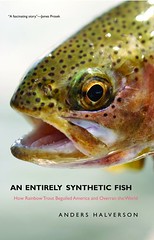 Halverson, Anders. An Entirely Synthetic Fish: How Rainbow Trout Beguiled America and Overran the World. 2010. Yale University Press. Hardbound: 257 pages. Price: $26.00 U.S. [Amazon: $17.16].
Halverson, Anders. An Entirely Synthetic Fish: How Rainbow Trout Beguiled America and Overran the World. 2010. Yale University Press. Hardbound: 257 pages. Price: $26.00 U.S. [Amazon: $17.16].
SUMMARY: Anders Halverson provides an exhaustively researched and grippingly rendered account of the rainbow trout and why it has become the most commonly stocked and controversial freshwater fish in the United States. Discovered in the remote waters of northern California, rainbow trout have been artificially propagated and distributed for more than 130 years by government officials eager to present Americans with an opportunity to get back to nature by going fishing. Proudly dubbed "an entirely synthetic fish" by fisheries managers, the rainbow trout has been introduced into every state and province in the United States and Canada and to every continent except Antarctica, often with devastating effects on the native fauna. Halverson examines the paradoxes and reveals a range of characters, from nineteenth-century boosters who believed rainbows could be the saviors of democracy to twenty-first-century biologists who now seek to eradicate them from waters around the globe. Ultimately, the story of the rainbow trout is the story of our relationship with the natural world -- how it has changed and how it startlingly has not.
RECOMMENDATION: For those with an interest in the trout fishery and/or invasive species.
You can read all the Birdbooker Reports in the archives on this site, and Ian now has his own website, The Birdbooker's Bookcase, where you can read his synopses about newly published science, nature and animal books. But Ian assures me that he still loves us here, so he'll still share his weekly Birdbooker Reports with us!





